Abstract
The diagnosis of diseases in their early stages can assist us in preventing life-threatening infections and caring for them better than in the last phase because prevention is better than cure. The death rate can be very high due to the unapproachability of diagnosed patients at an early point. Expert systems help us to defeat the problem mentioned above and enable us to automatically diagnose diseases in their early phases. Expert systems use a fuzzy, rule-based inference engine to provide forward-chain methods for diagnosing the patient. In this research, data have been gathered from different sources, such as a hospital, by performing the test on the patients’ age, gender, blood sugar, heart rate, and ECG to calculate the values. The proposed expert system for medical diagnosis can be used to find minimum disease levels and demonstrate the predominant method for curing different medical diseases, such as heart diseases. In the next step, the diagnostic test at the hospital with the novel expert system, the crisp, fuzzy value is generated for input into the expert system. After taking the crisp input, the expert system starts working on fuzzification and compares it with the knowledge base processed by the inference engine. After the fuzzification, the next step starts with the expert system in the defuzzification process converting the fuzzy sets’ value into a crisp value that is efficient for human readability. Later, the expert physician system’s diagnosis calculates the value by using fuzzy sets, and gives an output to determine the patient’s heart disease. In one case, the diagnosis step was accomplished, and the expert system provided the yield with the heart disease risk level as “low”, “high”, or “risky”. After the expert system’s responsibilities have been completed, the physician decides on the treatment and recommends a proper dose of medicine according to the level the expert system provided after the diagnosis step. The findings indicate that this research achieves better performance in finding appropriate heart disease risk levels, while also fulfilling heart disease patient treatment due to the physicians shortfalls.
1. Introduction
Fuzzy logic is the most widely used technique for the detection of minimum levels of a disease through analysis of the patient’s lab tests. Using this expert system, the doctor can accurately and efficiently diagnose the heart patient, saving both time and the patient’s patience. After the systematic diagnosis, the doctor advises the proper medicine to the patient to cure the disease. The authors’ study [1] describes an online system for the diagnosis of diabetes. They have focused on the causes of diabetes’ ability to cause a stroke to affect different diseases in the human body.
The focus of this study is to identify five significant complications from a diabetes attack. The proposed model contains the fuzzy-based model, which has been used to classify the five most significant risks of diabetes, such as blindness, kidney damage, heart attack, stroke disease, and other heart problems. Using an online system, the correct prediction rate is 92.5%. The patients can enter their symptoms of a diabetes attack online; their models are then matched with the database, and the required action is accurately recommended against the submission of a diabetes sample.
The research in [2] investigated an expert system for automatically diagnosing the disease in humans. They have used an automatic fuzzy, rules-based inference engine for the detection of the symptoms of the disease. The expert system has examined the diagnosis by getting the user’s knowledgebase information from an expert system through the rules formed for the inference engine and from the databases used worldwide for disease diagnosis and treatment [3,4]. The authors of [5] defined a well-known and informative system for the well-known phases of heart disease in humans. Everyone is well-aware that coronary heart disease is spreading among humans due to their lavish lifestyle and desire not to work. The authors of [6] investigated the claim that Parkinson’s disease is the most critical problem worldwide. The proposed genetic algorithm is an extreme learning expert system for use in treating Parkinson’s disease and more generally across the healthcare system [7,8,9,10,11]. The machine learning database collected data. For studying neurons, they used genetic algorithms, and, to calculate the performance, they used statistical methods such as classification, accuracy, sensitivity, etc.
Authors in [12] discovered a technique to diagnose heart disease using a genetic algorithm and fuzzy logic. They have designed a hybrid genetic fuzzy system to diagnose heart disease. Many features have been selected from the dataset, which helps to diagnose and classify the system using a fuzzy inference system. These rules have been chosen by using the genetic algorithm. They can select features such as serum, sex, cholesterol, maximum heart rate, etc.
Furthermore, ref. [13] encouraged the researchers to build mathematical data models using data mining rules. These rules assist them in making clinical decisions. The primary purpose of their research is to find disease from a minimal level by comparing the set of attributes made by the clinical dataset, and they used the Back Propagation Neural Network (BPNN).
The primary purpose of this research is to determine the current working expert system’s accuracy level and to improve the efficiency level of the existing expert system using fuzzy logic with full control and support. The proposed system has increased the performance of the expert system and can be used for multiple medical disease diagnoses with full control of fuzzy logic. Before, this doctor used manual methods for diagnosis and treatment, and many mistakes can happen with these methods. Fuzzy logic is used for approximation values for diagnosis and the best result of the disease at a minor level.
2. Related Work
The authors’ study [1] described an online system for diabetes diagnosis. They have focused on the causes of how diabetes and a stroke can affect different diseases in the human body. The focus of this study is to identify five major complications that arise from a diabetes attack. The proposed model contains the fuzzy-based model, which has been used to classify the five most significant risks due to diabetes, such as blindness, kidney damage, heart attack, stroke disease, and other heart problems. The correct prediction rate performed by the system is 92.5%. The patients can enter their symptoms of diabetes attack online; their models are then matched with the database and required action is accurately recommended against the submission of a diabetes sample.
The authors of [14] found that a multi-layered Mamdani fuzzy inference system (MI-MFIS) can be used to diagnose different stages of hepatitis B, such as no hepatitis, acute HBV or chronic HBV. This system has II input variables in stage 1 and VII input variables in stage 2. In the first layer, they examined the condition of the liver to be healthy or infectious. Intier 2, multiple variables were used to determine no hepatitis, acute HBV, or chronic HBV due to enzyme vaccination. All the data sets have been collected by the pathology department, which must be examined in this research paper.
Moreover, ref. [15] provided a method for practical applications and clinical suggestions regarding which type of decision should be considered for the study of the research regarding therapy. RCTs are the foremost important factor to consider in the clinical decision about treatment. However, the doctor should also know how to use this study adequately. The main work of RCTs is in the aspects of validity, results, and applications. Clinicians can use these practices for the best results in their practices and experience.
The authors of [16] proposed three main stages: pre-processing, feature extraction, and feature reduction with PCA and best classification. The experimental results and analysis show that the described method is best for elucidating the disease. The fuzzy-based expert system has some advantages of automation; it is speedy, cheap, and easy to diagnose the disease in the clinical application. The system is best for the early survey of the population.
The authors of [17] investigated some problems in creating fuzzy logic rules, such as speed and accuracy. They proposed a precise and fast fuzzy rule expert system to minimize these issues. In this system, rules are made from numeric data using an agreed approach based upon a selection–reduction method. Lastly, they created a redundancy index method for making rules for the expert system.
Similarly, authors in [2] investigated an expert system for the automatic diagnosis of diseases in humans. They used an automatic, fuzzy, rules-based inference engine for the detection of the symptoms of the disease. The expert system has examined the diagnosis by getting the user’s knowledgebase information from an expert system through the rules formed for the inference engine and from the databases used worldwide for disease diagnosis and treatment. The fuzzy-based expert system increases the system’s work by reducing the physician’s workload. After diagnosing the disease, the investigated system recommended that the doctor prescribe the medicine for the detected disease. In addition, a variety of approaches related to Alzheimer’s disease using neuroimaging are presented by the researchers to investigate such diseases [18,19,20].
The researchers of [21] encourage us through their work to detect disease using Enzyme-Linked Immune-Sorbent Assay (ELISA). As time goes on, medical research advances. Many bio marks have been used to detect different conditions at a different level, but many have no practical applications. The authors developed a technique to measure the glucose level in humans by using an Enzyme-Linked Immune-Sorbent Assay (ELISA). This includes the biological conversion of analyses into inverts, after which the glucose level can be examined. An ELISA kit produces quicker and more efficient results than other methods used for this purpose.
Authors in [22] described that they could manage diabetes by adding glucose and data of insulin pumping. They found that many variables have been defined for data collection, such as hours of sleep, heartbeat rate, daily walking routine, etc. This can be helpful for a doctor to make the right decision as regards the patient. A system has been developed using an AI scenario to assist the doctor in making decisions for the patient.
Similarly, authors in [23] concluded that about 45 million people all around the world have diabetes. Many applications of artificial intelligence (AI) and cognitive computing have been developed for disease cures. These systems have been helpful for persons with diabetes (PWDs), their families and their caregivers. These systems have been divided into four main areas: automated retinal screening, clinical decision support, predictive population risk stratification, and patient self-management tools.
3. Materials and Methods
This research has proposed an expert system for medical diagnosis to find accurate and a minimum disease level, and present the paramount system for different medical diseases, such as heart diseases. The proposed system obtains crisp input by asking questions about the patient, and fuzzy rules have been built based on blood symptoms and compared with the knowledge base, processed by the inference engine. The proposed system takes input and matches it with knowledge base rules; then, the rule is “fire.” Otherwise, the input can be refused by the system. In the case of rule fire, the system obtains the heart disease level from the available knowledge database diagnosis of heart disease.
Then, the system can be recommended to physicians to find the level of the disease after the proper diagnosis from the user given input. As the diagnosis ends, the physician prescribes an appropriate dose of the medicine to the patient. Now, the physician can recommend medication according to the medical expert system’s suggestion.
The expert system has taken the following steps for the implementation of the rules
- The system asks for input by asking the patient a question and obtains a crisp set;
- The inference engine compares the given input with the knowledge base expert system;
- Diagnosis of the disease from the expert system rules, such heart disease;
- Then the level of the disease after diagnosis is selected;
- Now the expert system recommends a proper dose of medicine for the patient.
The following tools and language have been used for the evaluation:
- Visual studio 2013;
- MATLAB;
- C/C++/C# language;
- Electrocardiogram (ECG);
- Holter monitoring;
- Echocardiogram;
- Angiography.
The proposed system describes the system workflow, as shown in Figure 1. How the system would work for getting input from the user after diagnosis on given medical diseases symptoms and suggest the physician take necessary action against the disease is depicted in Figure 1. This study examines the expert system working for heart disease diagnosis and treatment.
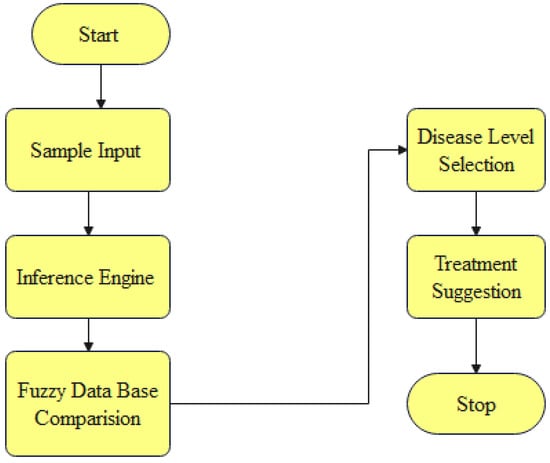
Figure 1.
The system flow diagram.
3.1. Input Parameters
3.1.1. Cholesterol
It is present in all the cells of the human body and, as such, cholesterol has a significant role in the digestion process of food. Moreover, it produces vitamin D and other hormones, and the human body produces it naturally. In appearance, it looks wary and fatty [24].
Types of Cholesterol
There are two types of cholesterol
- Low-density lipoproteins (LDL)
- High-density lipoproteins (HDL)
Cholesterol is an oil-based liquid or substance that cannot mix in the blood. Low-density lipoproteins (LDL) are unhealthy for humans and are called “bad” cholesterol, while high-density lipoproteins (HDL) are healthy for the human body and are called “good” cholesterol.
Function of Cholesterol
- It has four main functions.
- It helps to construct a cell wall;
- It helps in the production of digestive bile acid;
- It produces vitamin D;
- It helps to produce hormones in the body.
Causes of High Cholesterol
High cholesterol is a major risk factor for heart disease, as it may cause a heart attack. When the cholesterol level exceeds the standard level, it narrows the heart’s arteries and may impede blood flow. A high level of cholesterol shows no signs or symptoms. Regular tests and treatments can reduce this risk factor [25].
Level of Cholesterol
- Normal = 100–129 mg/dL
- High = 130–159 mg/dL
- Very high = 160–189 mg/dL
Remedies to reduce cholesterol level may follow the following:
- Proper heart-healthy diet;
- Proper exercise;
- Reducing weight;
- Avoiding smoking.
Treatment of Cholesterol
There are many ways to treat high cholesterol levels, such as:
- Lipid-lowering therapy;
- Statin safety.
3.1.2. Blood Pressure
The human heart is the main organ that supplies blood to all body organs. Our heart pumps the blood with every heartbeat, which circulates through the entire body through blood vessels. When it flows in the body, it puts pressure on the blood vessels’ walls.
Blood pressure values can be measured by the following [14]:
- Systolic blood pressure;
- Diastolic blood pressure;
- To check those things which are abnormal.
Its basic unit is millimeters of mercury (mmHg).
Ranges of Blood Pressure
Standard blood pressure assortments are determined if the reading lies between 140/mmHg systolic and 90 mmHg diastolic. High blood pressure assortments are determined if the reading is over 140/mmHg systolic and 90/mmHg diastolic. Blood pressure should be measured throughout the day because it fluctuates due to stress or physical exertion. Today, digital blood pressure monitors are used. However, whenever someone wants to measure blood pressure using a digital monitor, their arm should be straight; otherwise, the reading may be disturbed [26].
3.1.3. Chest pain
It is also called acute abdominal pain. If abdominal pain is severe, it must be treated on a priority basis because it is a symptom of a heart issue. There are many causes of abdominal pain, such as infection, inflammation, rupture of organs or any blockage in the flow of blood [27].
Symptoms
- Low blood pressure;
- Constant pain increases over time;
- The abdomen may be swelling out;
- Extreme pain in the abdomen;
- Difficulty when taking a breath.
- Sudden vomiting;
- Pain in the centre of the abdomen, burning or tightness;
- Hot or cold sweat.
3.1.4. Blood Sugar
The amount of sugar in human blood is called the blood sugar level. It may vary due to diet, food, or exercise. It can be measured in millimeters per deciliter of blood after digestion of food. Sugar takes between 15 and 30 min to mix with blood. Still, liquids mix with blood more quickly. Sugar in our body is converted into glucose, a source of energy. However, when the glucose level exceeds the required standard, it may cause diabetes [28].
3.1.5. Heart Rate
Humans can determine their health or fitness levels through their heart rate, which is the number of heart beats per minute. It varies from person to person, and one can find one’s heart rate through their wrist or the side of the neck. It can also be helpful to learn about different health problems as some other factors also affect the heart rate, such as body weight, body size, air pressure, temperature, etc., [14].
3.1.6. Electrocardiogram
An electrocardiogram (ECG) is a test that determines the heart’s function to show whether it is working properly. This test has been used to determine heart disease, and it can find the following results [29]:
- Heartbeat motion;
- Diagnosis of a heart attack.
3.1.7. Glucose Meter
A medical device is used to determine the level of glucose in the blood. Nowadays, a strip of glucose paper is dipped in a substance to measure glucose level. A drop of blood is used on the strip to find the sugar level in [30].
3.1.8. Lipid Plus Device
The Lipid Plus device is used to measure the exact cholesterol level in the human body. A test strip is used to measure the level of cholesterol. It is a cheap testing device, which may also be used at home. It is a user-friendly device and easy to operate [31].
3.1.9. Holter Monitor
It is a small device used to identify the heart’s rhythm. It may vary throughout the day to monitor the heart’s rhythm for 24 h. This test is done after (ECG) reports. If the (ECG) report is not satisfying, then the Holter monitor must be used to identify the heart’s rhythm [32,33].
3.1.10. Blood Pressure Monitor
A sphygmomanometer is also known as a blood pressure monitor. This device is used to measure blood pressure. A simple sphygmomanometer consists of an inflatable cuff, a measuring unit, and a mechanism for inflation. It can be operated manually by a bulb and value [34].
3.2. Proposed System Flow
The flow of the proposed expert system is given and described in the following steps.
- Step 1: Input chest pain level and heart electrical signal in the body;
- Step 2: Input the blood sugar level;
- Step 2: Input the heart rate;
- Step 5: Input blood pressure;
- Step 6: Input the gender and age of the patient;
- Step 7: Input the cholesterol value;
- Step 8: The doctor starts the diagnosis on the fuzzy-based expert system;
- Step 9: Diagnosis report is generated;
- Step 10: The doctor advises the patient on the proper dose of medicine to cure heart disease;
- Step 11: Then, the system is terminated.
3.2.1. Fuzzy Rules Member Functions
Fuzzy rules have been developed by applying the following formula for all fuzzy set’s member functions
Formula = mn
M is the membership function, and n are input
For ECG: there are 3 membership (m) functions, and input (n) is 1
31 = 3
For Chest Pain: there are 3 membership (m) functions, and input (n) is 1
31 = 3
For Blood Sugar: there are 4 membership (m) functions, and input (n) is 1
41 = 4
For Cholesterol: there are 3 membership (m) functions, and input (n) is 1
31 = 3
For Blood Pressure: there are 3 membership (m) functions, and input (n) is 1
31 = 3
For Heart Rate: there are 3 membership (m) functions, and input (n) is 1
31 = 3
For AGE: there are 4 membership (m) functions and input (n) are 1
41 = 4
Thus, it has calculated the total number of fuzzy rules by multiplying all the outputs of the fuzzy set member function by applying the above-cited formula = mn
= mn × mn
= 31 × 31 × 41 × 31 × 31 × 31 × 41
= 35 × 42
= 3888
Total number of 3888 rules by given input
3.2.2. Fuzzy Inputs and Output
The fuzzy inputs and outputs are presented in Table 1.

Table 1.
The fuzzy input/output rule.
3.2.3. Fuzzy-Based Expert System Workflow
- Set the result to false;
- Input the ECG Value;
- Input Chest pain level;
- Input the Blood Sugar level;
- Input the Cholesterol value;
- Input the Blood Pressure level;
- Input the Age of the patient;
- Input the Heart Rate of the patient;
- Then, the system will start the diagnosis of the given values, such as blood pressure and sugar levels;
- Then select the Recommendation level;
- And recommend the proper dose to the patient;
- Setup 2 is complete;
- Display true;
- Exit.
3.3. Dataset
The dataset has been obtained from THQ Tehsil Based Hospital Yazman under the supervision of Expert Doctors. It has utilized Visual Studio and MATLAB tools to implement the thesis’ research. It has already made 3888 rules by fuzzy logic; now, it is time for implementation. Thus, an application with the help of C# language has designed and applied 3888 rules and got the desired output by giving values.
4. Simulation and Results
The fuzzy logic makes all rules, then rules are made by the MATLAB to take results. Finally, the rules are implemented using the Visual Studio Ultimate 2013 version from Microsoft. C# visual language is used for suggestions and recommendations for the patient and the doctor. Data have been collected from different sources, such hospitals, by performing tests on the patients’ age, gender, blood sugar, heart rate, and ECG to calculate the value after the test process is completed. In the next step, diagnosis tests at the hospital by the expert system, the crisp, fuzzy value is generated for input into the expert system. After taking the crisp input, the expert system starts working on fuzzification. The next step starts with the expert system in the defuzzification process converting fuzzy sets’ values to a crisp value that is efficient for human readability. After receiving the diagnosis from the expert, the physician’s expert system calculates the value using fuzzy sets and gives an output to determine the patient’s heart disease. Once the diagnosis step is complete, the expert system gives the output as the level of heart disease risk: low, high, or risky. After the expert system’s responsibilities have been completed, the physician decides on treatment and recommends a proper dose of medicine according to the level the expert system provided after the diagnosis step. Simulation and results show that this research achieves better performance in determining proper heart disease risk levels, while the other fulfills the needs of heart disease patient treatment. Simulation results follow to show heart disease risk levels.
Figure 2 shows the ECG levels. The system shows the output after taking the values of ECG as input and presents the levels of ECG, which are normal, high, and very high.
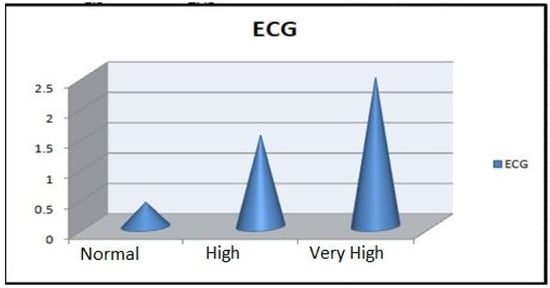
Figure 2.
ECG levels.
Figure 3 shows the chest pain levels from given input by the doctor, and, after taking input, it describes the levels, which are normal, high, and very high. Figure 4 represents the blood sugar levels from given input to the system, which then produces results as output, which are normal, high, and very high.
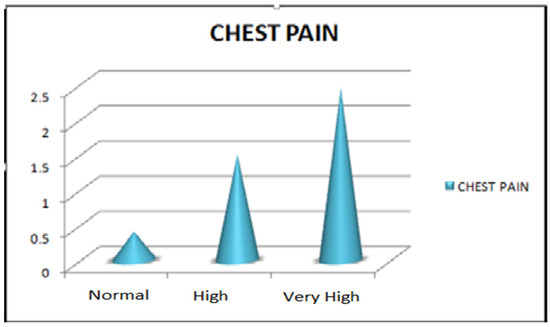
Figure 3.
Chest pain levels.
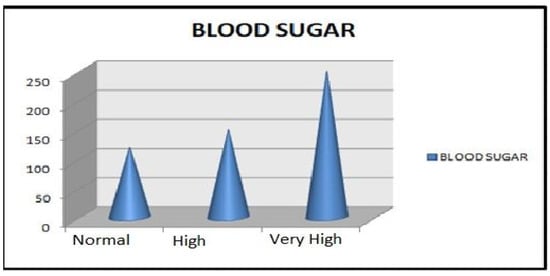
Figure 4.
Blood sugar levels.
Figure 5 presents the patients’ cholesterol levels. It shows the risk factors by output, which describes normal, high, or very high cholesterol levels. Figure 6 presents the blood pressure levels by taking input from the physician and helping him find out the level of the blood pressure.
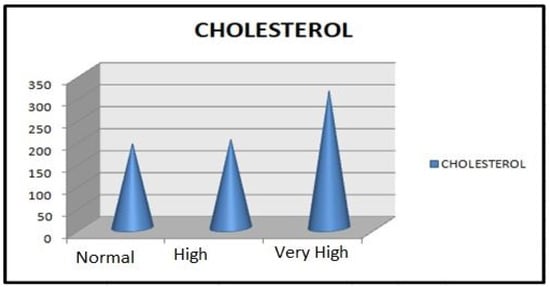
Figure 5.
Cholesterol levels.
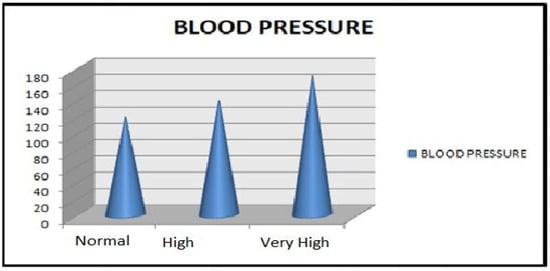
Figure 6.
Blood pressure levels.
An expert system for heart diseases diagnosis and treatment, showing the patients’ age levels by taking input from the user is presented in Figure 7. The user inputs the patient’s age, and the system will produce a level of disease according to the age factor. Figure 8 shows the heart rate levels of the patients using results from different medical apparatus and using these results as input to produce a level of the heart rate.
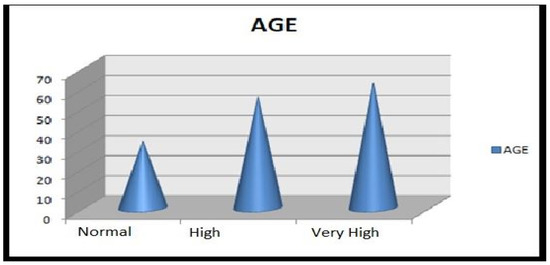
Figure 7.
Levels of the patients’ age.
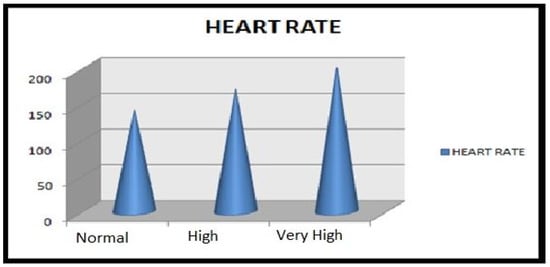
Figure 8.
Patients’ heart rate levels.
This expert system for heart diseases diagnosis and treatment shows the levels after all the inputs given by the user and suggests the physician doctor the level of heart disease (shown in Figure 9).
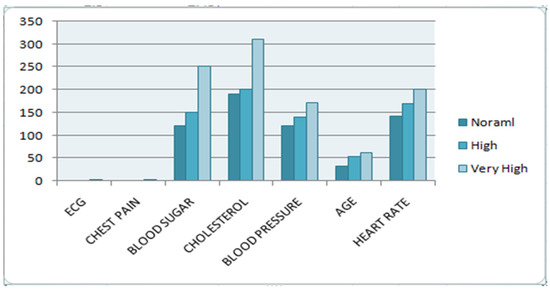
Figure 9.
The levels of heart disease output.
4.1. Patient Selected for Diagnosis and Treatment
At the Tehsil headquarters hospital Yazman District Bahawalpur, ten patients were randomly selected under the supervision of expert doctors for diagnosis and treatment. These patients kept in touch daily for routine checkups; random inputs from these were fed into the implemented system and results were taken according to the fuzzy rules that are implemented in the system using MATLAB, and then implemented into the application in visual C# language, after which results were taken again. All results of the diagnosis of the patient and the fuzzy rules member function follow (Figure 10, Figure 11, Figure 12 and Figure 13).
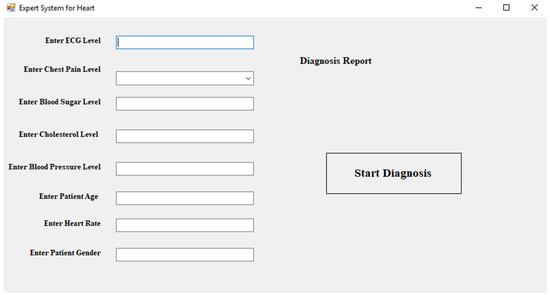
Figure 10.
Expert system simulation in C# main interface of the system.

Figure 11.
ECG 2.5, Chest Pain Normal, Sugar 100, Cholesterol 120, BP 130, Age 35, Heart Rate 130 and Gender Male, output system is “Normal”.

Figure 12.
ECG 2.4, Chest Pain Typical Angina, Sugar 140, Cholesterol 195, BP 145, Age 43, Heart Rate 155 and Gender Male, output system is “High”.
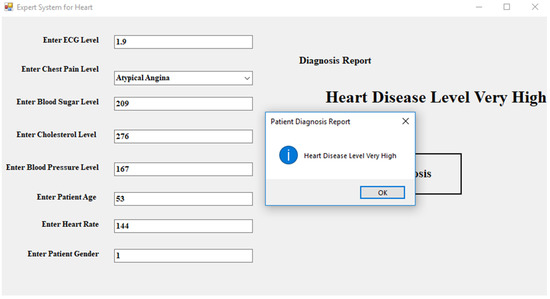
Figure 13.
ECG 1.9, Chest Pain Atypical Angina, Sugar 209, Cholesterol 276, BP 167, Age 53, Heart Rate 144 and Gender Female, output System is “Very High”.
4.2. Accuracy Level of Expert System
An expert opinion has been formed according to the multiple test results conductedby the patients. The average accuracy level of the system after test results and expert opinion is 95.5%, which is above all the percentages of expert systems that have already been created for finding different diseases. Table 2 shows the test results and expert opinion. It also describes the accuracy level of the expert system.

Table 2.
Test results and expert opinion.
5. Conclusions
In the proposed research, all input is taken from the patient and then evaluated by the expert doctor at THQ Tehsil Level Hospital, who verified all the test results. The evaluation of the system is designed very effectively, and the system is more reliable and beneficial for the doctor and the patient, reducing the rush at the hospital to avoid continuous patient monitoring. A fuzzy expert system is helpful and useful for all patients and doctors to diagnose heart disease patients. Fuzzy member functions and fuzzy rules have been made by fuzzy logic. 3888 rules were made, and used. After that, the results were implemented using the C# application, which is specially designed for the expert system for heart disease diagnosis and treatment, and all the results were put together.
Author Contributions
Conceptualization, T.M. and Q.N.; methodology, T.M. and Q.N.; software, T.M. and Q.N.; validation, I.H., M.M.K. and I.U.; formal analysis, I.U., T.K. and H.G.M.; investigation, T.M and I.H.; resources, T.M., M.M.K. and I.U.; data curation, T.K, H.G.M. and N.A.; writing—original draft preparation, T.M., I.H. and Q.N.; writing—review and editing, I.U., T.K and Q.N.; visualization, Q.N., I.H. and I.U.; supervision, M.M.K. and I.U.; project administration, I.U. and H.G.M.; funding acquisition, H.G.M. and N.A. All authors have read and agreed to the published version of the manuscript.
Funding
Princess Nourah bint Abdulrahman University Researchers Supporting Project number (PNURSP2022TR140), Princess Nourah bint Abdulrahman University, Riyadh, Saudi Arabia.
Data Availability Statement
The data presented in this study are available on request from the corresponding author. The data are not publicly available because the project is not yet completed.
Acknowledgments
Princess Nourah bint Abdulrahman University Researchers Supporting Project number (PNURSP2022TR140), Princess Nourah bint Abdulrahman University, Riyadh, Saudi Arabia.
Conflicts of Interest
The authors of this article declare no conflicts of interest.
References
- Pavate, A.; Nerurkar, P.; Ansari, N.; Bansode, R. Early Prediction of Five Major Complications Ascends in Diabetes Mellitus Using Fuzzy Logic. In Soft Computing in Data Analytics; Springer: Berlin/Heidelberg, Germany, 2019; pp. 759–768. [Google Scholar]
- Khairina, D.M.; Hatta, H.R.; Rustam, R.; Maharani, S. Automation Diagnosis of Skin Disease in Humans using Dempster-Shafer Method. E3S Web Conf. 2018, 31, 11006. [Google Scholar] [CrossRef]
- Ahmad, S.; Ullah, T.; Ahmad, I.; Al-Sharabi, A.; Ullah, K.; Khan, R.A.; Rasheed, S.; Ullah, I.; Uddin, N.; Ali, S. A Novel Hybrid Deep Learning Model for Metastatic Cancer Detection. Comput. Intell. Neurosci. 2022, 2022, 8141530. [Google Scholar] [CrossRef] [PubMed]
- Wahab, F.; Ullah, I.; Shah, A.; Khan, R.A.; Choi, A.; Anwar, M.S. Design and implementation of real-time object detection system based on single-shoot detector and OpenCV. Front. Psychol. 2022, 13, 1039645. [Google Scholar] [CrossRef] [PubMed]
- Srivastava, P.; Sharma, N. Fuzzy risk assessment information system for coronary heart disease. In International Conference on Innovative Computing and Communications; Springer: Berlin/Heidelberg, Germany, 2019. [Google Scholar]
- Avci, D.; Dogantekin, A. An Expert Diagnosis System for Parkinson Disease Based on Genetic Algorithm-Wavelet Kernel-Extreme Learning Machine. Park. Dis. 2016, 2016, 1–9. [Google Scholar] [CrossRef] [PubMed]
- Bin Tufail, A.; Ma, Y.-K.; Zhang, Q.-N.; Khan, A.; Zhao, L.; Yang, Q.; Adeel, M.; Khan, R.; Ullah, I. 3D convolutional neural networks-based multiclass classification of Alzheimer’s and Parkinson’s diseases using PET and SPECT neuroimaging modalities. Brain Inform. 2021, 8, 1–9. [Google Scholar] [CrossRef] [PubMed]
- Ahmad, I.; Ullah, I.; Khan, W.U.; Rehman, A.U.; Adrees, M.S.; Saleem, M.Q.; Cheikhrouhou, O.; Hamam, H.; Shafiq, M. Efficient Algorithms for E-Healthcare to Solve Multiobject Fuse Detection Problem. J. Health Eng. 2021, 2021, 1–16. [Google Scholar] [CrossRef]
- Tufail, A.B.; Ullah, I.; Khan, W.U.; Asif, M.; Ahmad, I.; Ma, Y.K.; Khan, R.; Kalimullah; Ali, S. Diagnosis of diabetic retinopathy through retinal fundus images and 3D convolutional neural networks with limited number of samples. Wirel. Commun. Mob. Comput. 2021, 2021, 6013448. [Google Scholar] [CrossRef]
- Sadiq, M.T.; Yu, X.; Yuan, Z.; Zeming, F.; Rehman, A.U.; Ullah, I.; Li, G.; Xiao, G. Motor Imagery EEG Signals Decoding by Multivariate Empirical Wavelet Transform-Based Framework for Robust Brain–Computer Interfaces. IEEE Access 2019, 7, 171431–171451. [Google Scholar] [CrossRef]
- Tufail, A.B.; Ma, Y.K.; Kaabar, M.K.; Martínez, F.; Junejo, A.R.; Ullah, I.; Khan, R. Deep learning in cancer diagnosis and prognosis prediction: A minireview on challenges, recent trends, and future directions. Comput. Math. Methods Med. 2021, 2021, 9025470. [Google Scholar] [CrossRef]
- Santhanam, T.; Ephzibah, E.P. Heart Disease Prediction Using Hybrid Genetic Fuzzy Model. Indian J. Sci. Technol. 2015, 8, 797. [Google Scholar] [CrossRef]
- Nahato, K.B.; Harichandran, K.N.; Arputharaj, K. Knowledge mining from clinical datasets using rough sets and backpropagation neural network. Comput. Math. Methods Med. 2015, 2015, 460189. [Google Scholar] [CrossRef] [PubMed]
- Mirmozaffari, M. Developing an expert system for diagnosing liver diseases. Eur. J. Eng.Technol. Res. 2019, 4, 1–5. [Google Scholar]
- Shiban, E.; Meyer, B. Treatment for Acute, Subacute and Chronic Low Back Pain. In Spine Surgery; Springer: Berlin/Heidelberg, Germany, 2019; pp. 3–8. [Google Scholar]
- Martinez, R.; Tong, M.; Diago, L.; Nummenmaa, T.; Nummenmaa, J. Fuzzy Simulation of Human Behaviour in the Health-e-Living System. In Uncertainty Management with Fuzzy and Rough Sets; Springer: Berlin/Heidelberg, Germany, 2019; pp. 157–172. [Google Scholar]
- Dutu, L.-C.; Mauris, G.; Bolon, P. A Fast and Accurate Rule-Base Generation Method for Mamdani Fuzzy Systems. IEEE Trans. Fuzzy Syst. 2017, 26, 715–733. [Google Scholar] [CrossRef]
- Bin Tufail, A.; Ullah, K.; Khan, R.A.; Shakir, M.; Khan, M.A.; Ullah, I.; Ma, Y.-K.; Ali, S. On Improved 3D-CNN-Based Binary and Multiclass Classification of Alzheimer’s Disease Using Neuroimaging Modalities and Data Augmentation Methods. J. Health Eng. 2022, 2022, 1–14. [Google Scholar] [CrossRef] [PubMed]
- Rehman, A.U.; Naqvi, R.A.; Rehman, A.; Paul, A.; Sadiq, M.T.; Hussain, D. A Trustworthy SIoT Aware Mechanism as an Enabler for Citizen Services in Smart Cities. Electronics 2020, 9, 918. [Google Scholar] [CrossRef]
- Bin Tufail, A.; Anwar, N.; Ben Othman, M.T.; Ullah, I.; Khan, R.A.; Ma, Y.-K.; Adhikari, D.; Rehman, A.U.; Shafiq, M.; Hamam, H. Early-Stage Alzheimer’s Disease Categorization Using PET Neuroimaging Modality and Convolutional Neural Networks in the 2D and 3D Domains. Sensors 2022, 22, 4609. [Google Scholar] [CrossRef]
- Zhu, X.; Sarwar, M.; Zhu, J.-J.; Zhang, C.; Kaushik, A.; Li, C.-Z. Using a glucose meter to quantitatively detect disease biomarkers through a universal nanozyme integrated lateral fluidic sensing platform. Biosens. Bioelectron. 2019, 126, 690–696. [Google Scholar] [CrossRef]
- Rigla, M.; García-Sáez, G.; Pons, B.; Hernando, M.E. Artificial Intelligence Methodologies and Their Application to Diabetes. J. Diabetes Sci. Technol. 2017, 12, 303–310. [Google Scholar] [CrossRef]
- Dankwa-Mullan, I.; Rivo, M.; Sepulveda, M.; Park, Y.; Snowdon, J.; Rhee, K. Transforming Diabetes Care Through Artificial Intelligence: The Future Is Here. Popul. Health Manag. 2019, 22, 229–242. [Google Scholar] [CrossRef]
- Julia, T.C.W.; Qian, L.; Pipalia, N.H.; Chao, M.J.; Liang, S.A.; Shi, Y.; Jain, B.R.; Bertelsen, S.E.; Kapoor, M.; Marcora, E.; et al. Cholesterol and matrisome pathways dysregulated in astrocytes and microglia. Cell 2022, 185, 2213–2233.e25. [Google Scholar]
- Grundy, S.M.; Vega, G.L. Causes of high blood cholesterol. Circulation 1990, 81, 412–427. [Google Scholar] [CrossRef] [PubMed]
- Rohan, R.; Venkadeshwaran, K. Measurement of Human Blood Pressure using MEMS Pressure Sensor. In Proceedings of the 2022 9th International Conference on Computing for Sustainable Global Development (INDIACom), New Delhi, India, 23–25 March 2022. [Google Scholar]
- Kucia, A.M.; Beltrame, J.F.; Keenan, J. Chest Pain Assessment. In Cardiac Care: A Practical Guide for Nurses; Wiley-Blackwell: New York, NY, USA, 2022; pp. 216–230. [Google Scholar]
- Somogyi, M. Determination of blood sugar. J. Biol. Chem. 1945, 160, 69–73. [Google Scholar] [CrossRef]
- Mincholé, A.; Camps, J.; Lyon, A.; Rodríguez, B. Machine learning in the electrocardiogram. J. Electrocardiol. 2019, 57, S61–S64. [Google Scholar] [CrossRef] [PubMed]
- Cao, Y.; Mo, F.; Liu, Y.; Liu, Y.; Li, G.; Yu, W.; Liu, X. Portable and sensitive detection of non-glucose target by enzyme-encapsulated metal-organic-framework using personal glucose meter. Biosens. Bioelectron. 2021, 198, 113819. [Google Scholar] [CrossRef] [PubMed]
- Bastianelli, K.; Ledin, S.; Chen, J. Comparing the Accuracy of 2 Point-of-Care Lipid Testing Devices. J. Pharm. Pract. 2016, 30, 490–497. [Google Scholar] [CrossRef]
- Mubarik, A.; Iqbal, A.M. Holter Monitor. In StatPearls; StatPearls Publishing: Tampa, FL, USA, 2022. [Google Scholar]
- Tufail, A.B.; Ullah, I.; Rehman, A.U.; Khan, R.A.; Khan, M.A.; Ma, Y.-K.; Hussain Khokhar, N.; Sadiq, M.T.; Khan, R.; Shafiq, M.; et al. On Disharmony in Batch Normalization and Dropout Methods for Early Categorization of Alzheimer’s Disease. Sustainability 2022, 14, 14695. [Google Scholar] [CrossRef]
- Silva, G.R.A.; Silva, M.S.; Guillo, L.A. Waist Circumference Above 80 cm Predicts Increased Systolic Blood Pressure in Healthy Young Adult Women. Int. J. Cardiovasc. Sci. 2020, 33, 340–347. [Google Scholar]
Publisher’s Note: MDPI stays neutral with regard to jurisdictional claims in published maps and institutional affiliations. |
© 2022 by the authors. Licensee MDPI, Basel, Switzerland. This article is an open access article distributed under the terms and conditions of the Creative Commons Attribution (CC BY) license (https://creativecommons.org/licenses/by/4.0/).